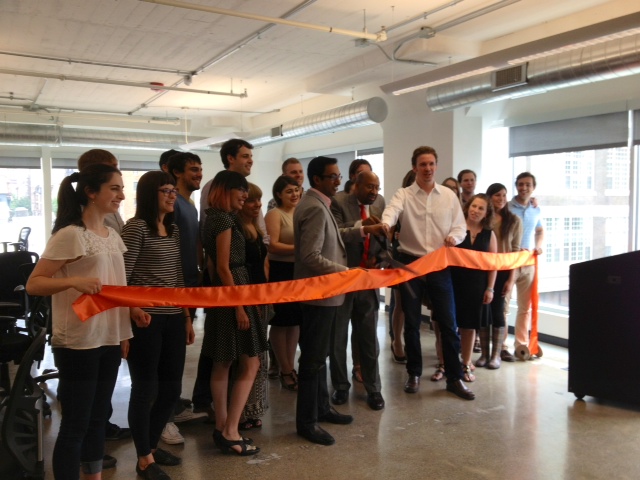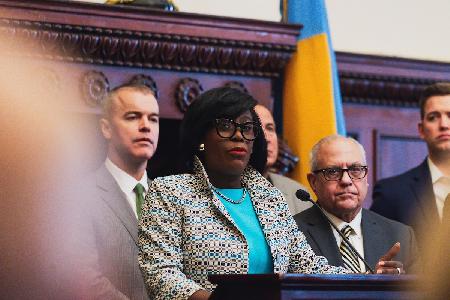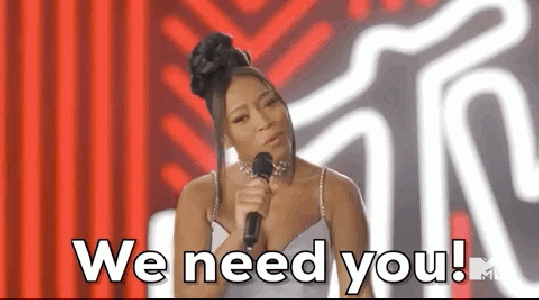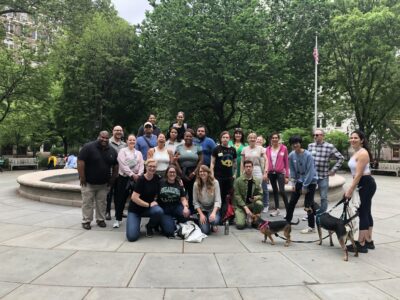The first and so far only president and CEO of Philadelphia’s Center City District (CCD) has been in his role since the earliest days of the organization, taking the helm in January 1991. This month, after more than three decades working on strengthening Philadelphia’s downtown, Levy announced he’d be transitioning out of his role at the end of the year.
The transition plan is a long one. After Dec. 31, 2023, CCD’s current VP for parks and public realm, Prema Katari Gupta, will take over as head. But Levy will stay on for an additional year as a non-executive chair of the board, offering the org strategic assistance as needed.
He’s seen the city through highs and lows, economic downturn and lots of development, and as it embraces new technologies and industries. In his last year in the job, he’s reflecting on the CCD’s last three decades of strategies and choices that made Center City the place it is today — home to thousands of residents, businesses, and a vibrant arts and cultural scene.
In an interview with Technical.ly, Levy shared his history of Center City, how he viewed the tech scene as it grew here, and what the pandemic taught him about going back to basics for public spaces.
The phases of Center City
When he joined CCD more than three decades ago, the city was going through a huge moment of development. In 1987, Center City became home to skyscraper One Liberty Place, and a few years after, Two Liberty Place. It was a controversial decision to build taller than the William Penn statue at the top of City Hall, Levy said (see: the “curse of Billy Penn“).
“Clearly the skyline was changing, there was a lot of momentum at that time for Center City,” Levy said of the ’80s. He previously worked in development at the University of Pennsylvania; “I remember when I was at Penn, I used to say that crossing the Schuylkill River was like crossing City Avenue.”
The economic downturn of 1989 and 1990 had a negative effect on the real estate industry at the time, and when Levy came into his role at CCD in 1991, the focus wasn’t on making the downtown pop — it was on starting with the basics. In the early 1990s, office buildings were being erected downtown, but past 5:30 p.m., the sidewalks were empty, he said. A civic and business leadership group formed to address issues of safety and cleanliness downtown, and the CCD’s first phase was born: “Clean and safe.”
“There was a real discontinuity, or contrast, let’s say, between the momentum of the office district and the quality of the public environment,” Levy said.

Billy Penn beside One Liberty Place. (Photo by G. Widman for GPTMC/George Widman Photography LLC)
CCD’s objective was to get people feeling comfortable spending time in Center City past just working hours, so it started staffing sidewalk cleanup crews, and improved lighting and visibility. After 18 months, the org moved on to a new objective: “Make it a night,” with a goal to get retailers to stay open until 8 p.m. on Wednesdays.
Expansion of CCD’s work followed, including revitalizing the “Avenue of the Arts,” promoting conventions within the city — the opening of the Pennsylvania Convention Center in 1993 helped — and adding streetscaping improvements like directional signs and banners for different neighborhoods. Levy said the CCD was acting in tandem with many other agencies at the time. And then: The 10-year tax abatement rule passed in 1997, incentivizing developers to turn vacant office buildings into retail and residential buildings.
The movement was called “turning on the lights upstairs.” Within a few years, Center City was flooded with condos and apartments. People were no longer just working downtown, but living, shopping and seeking entertainment there.
“Ten years after we started, Center City was a much more vibrant place,” Levy said. (Check out the City of Philadelphia’s 2018 study on the impacts of the abatement program.)
The tech boom
In the late 1990s, there was a lot of confidence in the city that the “so-called tech boom” was going to change Philly’s economy in a drastic way.
But a giant movement never came. In 2014, Levy spoke to Technical.ly about the tech economy’s role in brand building and talent acquisition in Philadelphia, but said it wouldn’t lead the city’s economy on its own.
“If you take all the tech startups together, I’m not sure they’d fill 100,000 square feet of commercial real estate,” Levy said at the time.

Employees of Curalate pose with then-Mayor Michael Nutter for a ribbon cutting at the tech company’s new Center City office in July 2013. (Technical.ly photo)
In 2023, that still feels true, he said. There are the huge employers like Comcast, which has made a dent in pedestrian activity in Center City post-pandemic by calling its 8,000 employees back to the office. Levy said he instead watched a surge of small business startups move in across the city, though they didn’t all gather downtown, but in clusters in different neighborhoods, like Old City’s “Nerd Street” aka North Third Street.
“We never became Amazon in Seattle, right? Or what’s happened in San Francisco,” Levy said. “But thank god for that, in some sense, because a lot of those cities got over-concentrated in technology.” Philadelphia has long been a slow-growth business city in all sectors, which means it also didn’t overbuild office buildings like other regions did, he said. The tech jobs came mostly in the form of startups, steadily growing small businesses, and in tech roles in adjacent industries like healthcare, life sciences and education.
Public spaces and the pandemic
When the pandemic hit in early 2020, office attendance and non-essential business halted. It was a challenging, scary time for all, but it was also a chance to bring his organization “back to basics,” Levy said.
In the early 2000s, when some of the foundational work around making the city cleaner, safer and more mixed-use was laid, the CCD focused on public spaces. It invested in Sister Cities Park along the Ben Franklin Parkway, then in John Collins Park at 17th and Chestnut streets. In the last decade, City Hall’s front yard, Dilworth Park, has been rethought and redeveloped.
Those public spaces became “absolute lifelines” during the pandemic, Levy said.
“I remember saying some time in 2020 to our staff, ‘You know, we know how to do this. It’s 1991 all over again,'” Levy said. “And I realized half my staff wasn’t born in 1991, but the approach was the same. … We didn’t know what this virus was. We didn’t know if you could get it by touching things, right? But being outside was obviously safer than inside. So we had to keep public spaces clean and safe.”

Dilworth Park. (Photo by E. Frizzelle for Visit Philadelphia)
The physical impact of being visible and doing things for the sake of the public environment was huge in 2020. Work that could go remote did, but that only accounts for about 40% of all jobs in Philadelphia, according to Levy. SEPTA, retail, food service, hospitality and maintenance workers continued working in person. And though Center City office buildings took a hit with remote work, real estate grew in other areas, like in University City.
Ultimately, Philadelphia’s Center City didn’t take the extreme hit that some other cities did, Levy said, largely thanks to the diversification of the downtown corridor done over the last several decades. Though office workers were staying home, those living and working in Center City’s buildings kept the lights on downtown — just as they had in the ’90s.
As he transitions out of his role, Levy said the CCD will continue working toward its long-held goals for the downtown district. But nowadays, the playbook is different. With new technologies and innovations being implemented city-wide, Levy and incoming leader Gupta will have a lot more tools in the toolbox.
“What I find still exciting is we need to achieve the same objectives, but we need to achieve them in totally new and creative ways,” Levy said. “And that’s where the challenge and the excitement is. Because you can’t just take out the playbook from 1991 and do it over again, right? You have to rethink that, but that same message of visibility, taking care of the public environment and being visible improving the public environment, is the fundamental lesson I took away.”
Join the conversation!
Find news, events, jobs and people who share your interests on Technical.ly's open community Slack

Philly’s IT department fires long-tenured staff amid a high-level shakeup of priorities

Why is it so hard to find entry-level software engineering jobs?

This Week in Jobs: Get out there with 22 new job opportunities available to you!


